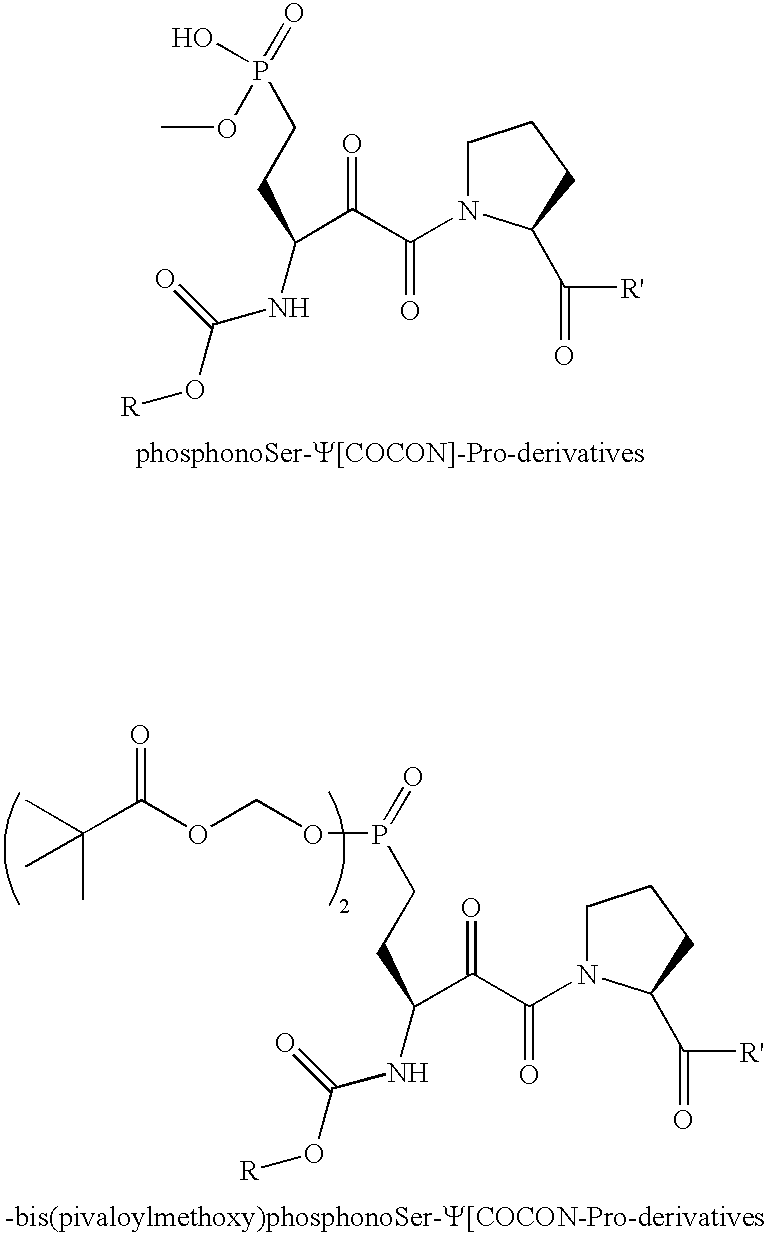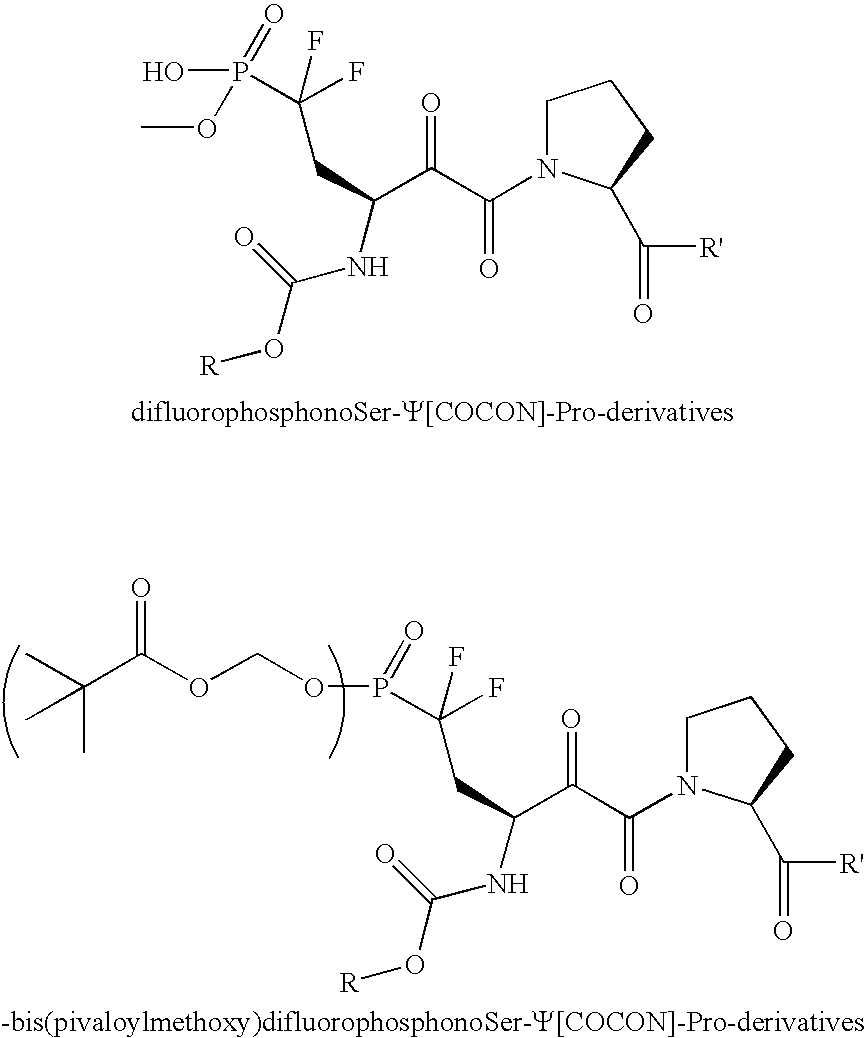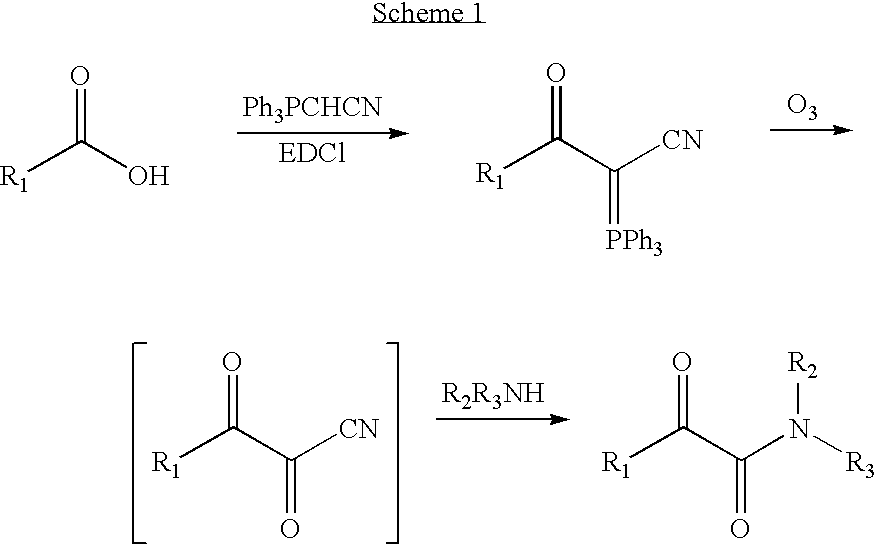Transition-state Inhibitors of Pin1, alpha-Ketoamide-containing peptidomimetics, and synthesis thereof
a technology of transition-state inhibitors and peptidomimetics, which is applied in the direction of peptide/protein ingredients, peptide sources, applications, etc., can solve the problems of difficult to achieve specificity (namely, enzyme specificity) by targeting kinases or phosphatases, unbioactive, and unphosphorylated counterparts bind poorly to targets
- Summary
- Abstract
- Description
- Claims
- Application Information
AI Technical Summary
Problems solved by technology
Method used
Image
Examples
example 1
[0035] The reaction scheme for the synthesis of the α-ketoamide Ala-Pro dipeptide analogue is shown in Scheme 4, which is a model reaction for synthesis of the α-ketoamide Ser-Pro dipeptide analogue. Additionally, the α-ketoamide Ala-Pro dipeptide analogue may be a potential inhibitor of cyclophilin.
[0036] In the first step, the ylide 1 was synthesized from a coupling reaction between commercially available (cyanomethylene)triphenylphosphorane and Boc-L-AlaOH with EDC in the presence of 4-dimethylaminopyridine. Under these conditions, a good yield of 80% was obtained.
[0037] In the second step, the ylide 1 was oxidized to an α,β-diketonitrile. This labile electrophile then was reacted in situ with HProOBn to form the α-keto amide 2. From NMR and MS spectra, this α-ketoamide 2 appeared to be obtained as a mixture of isomers in 45% yield.
example 2
[0038] The ozonolysis method of Example 1 was used in the synthesis of α-keto amide Ser-Pro dipeptide analogue (Scheme 5).
[0039] The ylide 3 was synthesized in an excellent yield of 90% by the same method as ylide 1. The Ser-Pro α-ketoamide 4 was obtained as a mixture of isomers in 35% yield. During purification of compound 4 on column, some decomposition happened, making purification of the crude product mixture difficult. For compound 4, at least four steps (hydrogenolysis, deprotection of Boc, protection with Fmoc and phosphorylation) were needed to prepare the phosphorylated FmocSer-Pro α-ketoamide 7 ready for solid phase synthesis of peptides.
[0040] Because the Fmoc protecting group is tolerant of ozonolysis according to the literature, FmocSer(Ot-Butyl)OH is selected as the starting material. The ylide 5 thus formed gives the α-ketoamide after ozonolysis and treatment with HProOt-Bu. Two steps are therefore saved in the synthesis of α-ketoamide 7. The ylide 5 has been prepa...
example 3
[0042] For assaying the inhibitory activities of the α-ketoamide inhibitor, Pin1 enzyme is used according to Scheme 8.
[0043] A series of different amines (see FIG. 1) and carboxylic acids (see FIG. 2) are coupled to the C-terminus and N-terminus to produce compounds of the type 10. In addition, cell permeable derivatives 11 are prepared to improve bioavailability.
[0044] Phosphate monoesters such as those used in the previous schemes are suitable for in vitro enzyme inhibition studies. However, problems with membrane permeability for phosphate esters are well known and reflected in the need for DMSO in cell-based assays conducted with Pin1 inhibitors. (Wang, X. J.; Xu, B.; Mullins, A. B.; Neiler, F. K.; Etzkom, F. A., (2004) Conformationally Locked Isostere of PhosphoSer-cis-Pro Inhibits Pin1 23-Fold Better than PhosphoSer-trans-Pro Isostere, J. Am. Chem. Soc., 126, 15533-15542.) Towards this end, to solve the problems of bioavailability conferred by the specificity of Pin1 for ph...
PUM
| Property | Measurement | Unit |
|---|---|---|
| dihedral angle | aaaaa | aaaaa |
| acid | aaaaa | aaaaa |
| conformational | aaaaa | aaaaa |
Abstract
Description
Claims
Application Information
 Login to View More
Login to View More - R&D
- Intellectual Property
- Life Sciences
- Materials
- Tech Scout
- Unparalleled Data Quality
- Higher Quality Content
- 60% Fewer Hallucinations
Browse by: Latest US Patents, China's latest patents, Technical Efficacy Thesaurus, Application Domain, Technology Topic, Popular Technical Reports.
© 2025 PatSnap. All rights reserved.Legal|Privacy policy|Modern Slavery Act Transparency Statement|Sitemap|About US| Contact US: help@patsnap.com



